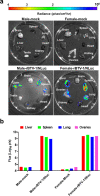Engineering recombinant replication-competent bluetongue viruses expressing reporter genes for in vitro and non-invasive in vivo studies
- PMID: 38353566
- PMCID: PMC10923215
- DOI: 10.1128/spectrum.02493-23
Engineering recombinant replication-competent bluetongue viruses expressing reporter genes for in vitro and non-invasive in vivo studies
Abstract
Bluetongue virus (BTV) is the causative agent of the important livestock disease bluetongue (BT), which is transmitted via Culicoides bites. BT causes severe economic losses associated with its considerable impact on health and trade of animals. By reverse genetics, we have designed and rescued reporter-expressing recombinant (r)BTV expressing NanoLuc luciferase (NLuc) or Venus fluorescent protein. To generate these viruses, we custom synthesized a modified viral segment 5 encoding NS1 protein with the reporter genes located downstream and linked by the Porcine teschovirus-1 (PTV-1) 2A autoproteolytic cleavage site. Therefore, fluorescent signal or luciferase activity is only detected after virus replication and expression of non-structural proteins. Fluorescence or luminescence signals were detected in cells infected with rBTV/Venus or rBTV/NLuc, respectively. Moreover, the marking of NS2 protein confirmed that reporter genes were only expressed in BTV-infected cells. Growth kinetics of rBTV/NLuc and rBTV/Venus in Vero cells showed replication rates similar to those of wild-type and rBTV. Infectivity studies of these recombinant viruses in IFNAR(-/-) mice showed a higher lethal dose for rBTV/NLuc and rBTV/Venus than for rBTV indicating that viruses expressing the reporter genes are attenuated in vivo. Interestingly, luciferase activity was detected in the plasma of viraemic mice infected with rBTV/NLuc. Furthermore, luciferase activity quantitatively correlated with RNAemia levels of infected mice throughout the infection. In addition, we have investigated the in vivo replication and dissemination of BTV in IFNAR (-/-) mice using BTV/NLuc and non-invasive in vivo imaging systems.IMPORTANCEThe use of replication-competent viruses that encode a traceable fluorescent or luciferase reporter protein has significantly contributed to the in vitro and in vivo study of viral infections and the development of novel therapeutic approaches. In this work, we have generated rBTV that express fluorescent or luminescence proteins to track BTV infection both in vitro and in vivo. Despite the availability of vaccines, BTV and other related orbivirus are still associated with a significant impact on animal health and have important economic consequences worldwide. Our studies may contribute to the advance in orbivirus research and pave the way for the rapid development of new treatments, including vaccines.
Keywords: IVIS; bluetongue virus (BTV); fluorescent protein; luciferase; non-structural protein 1 (NS1); reporter gene; reverse genetics.
Conflict of interest statement
The authors declare no conflict of interest.
Figures







Similar articles
-
Novel replication-competent reporter-expressing Rift Valley fever viruses for molecular studies.J Virol. 2025 Jan 31;99(1):e0178224. doi: 10.1128/jvi.01782-24. Epub 2024 Dec 12. J Virol. 2025. PMID: 39665546 Free PMC article.
-
Bi-Reporter Vaccinia Virus for Tracking Viral Infections In Vitro and In Vivo.Microbiol Spectr. 2021 Dec 22;9(3):e0160121. doi: 10.1128/Spectrum.01601-21. Epub 2021 Nov 24. Microbiol Spectr. 2021. PMID: 34817228 Free PMC article.
-
Monitoring SARS-CoV-2 Infection Using a Double Reporter-Expressing Virus.Microbiol Spectr. 2022 Oct 26;10(5):e0237922. doi: 10.1128/spectrum.02379-22. Epub 2022 Aug 18. Microbiol Spectr. 2022. PMID: 35980204 Free PMC article.
-
An updated review on bluetongue virus: epidemiology, pathobiology, and advances in diagnosis and control with special reference to India.Vet Q. 2020 Dec;40(1):258-321. doi: 10.1080/01652176.2020.1831708. Vet Q. 2020. PMID: 33003985 Free PMC article. Review.
-
Interferon α/β receptor knockout mice as a model to study bluetongue virus infection.Virus Res. 2014 Mar;182:35-42. doi: 10.1016/j.virusres.2013.09.038. Epub 2013 Oct 4. Virus Res. 2014. PMID: 24100234 Review.
Cited by
-
Novel replication-competent reporter-expressing Rift Valley fever viruses for molecular studies.J Virol. 2025 Jan 31;99(1):e0178224. doi: 10.1128/jvi.01782-24. Epub 2024 Dec 12. J Virol. 2025. PMID: 39665546 Free PMC article.
References
-
- Du Toit RM. 1944. The transmission of blue-tongue and horse-sickness by Culicoides. J Vet Sc Anim Ind 19:7–16. http://hdl.handle.net/2263/59110.
MeSH terms
Substances
Grants and funding
LinkOut - more resources
Full Text Sources
Medical
Research Materials

